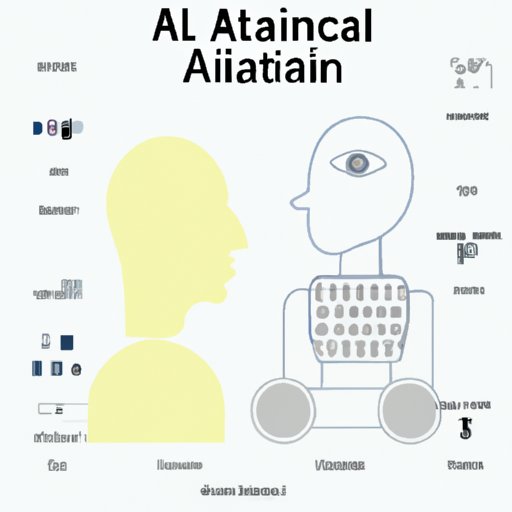Introduction: What is Artificial Intelligence (AI)?
Artificial Intelligence (AI) refers to computer systems that are built to mimic human intelligence and behavior. It is an interdisciplinary field of study combining elements from mathematics, engineering, computer science, and other related fields. AI has the ability to think and act rationally, to interpret data, and to learn from past experiences. AI can be used to solve complex problems, automate tasks, and provide insights into data.
The benefits of AI are vast. AI can improve efficiency, reduce costs, and increase accuracy. Additionally, AI can help to identify patterns and trends in data, enabling businesses to make better decisions. However, there are also some challenges associated with AI such as privacy issues, bias and discrimination, and accountability and responsibility.
History of AI Development
The history of AI development dates back to the 1950s. Early developments in AI focused on creating machines capable of solving problems and performing tasks traditionally done by humans. This early research was driven by a desire to understand how computers could be used to emulate human cognition. During this time, researchers developed algorithms and programming languages which enabled computers to process and interpret data.
In the 1980s and 1990s, AI experienced a resurgence in popularity. Researchers began to focus on developing machine learning algorithms and neural networks, which allowed computers to process large amounts of data and make decisions without human intervention. This period saw the emergence of technologies like facial recognition, natural language processing, and robotics.
Today, AI is being used in a variety of applications. From self-driving cars to virtual assistants, AI is becoming increasingly integrated into our daily lives. As advancements in technology continue, AI will become an even more integral part of our lives.

Understanding Machine Learning and Neural Networks
Machine learning and neural networks are two key components of AI. Machine learning is a type of artificial intelligence that enables computers to learn from data without being explicitly programmed. It involves using algorithms to find patterns in data and make predictions about future outcomes. Neural networks, on the other hand, are computer systems modeled after the human brain. They use interconnected layers of neurons to process data and make decisions.
Both machine learning and neural networks can be used to create powerful AI systems. Machine learning algorithms can be used to analyze large datasets and make accurate predictions. Neural networks can be used to solve complex problems such as image recognition and natural language processing.
How AI is Used in Everyday Life
AI is being used in a variety of ways in everyday life. Automation and robotics are two of the most common applications of AI. Automation is the process of automating manual labor, such as manufacturing processes. Robotics is the use of robots to complete tasks that would otherwise be too difficult or dangerous for humans. Both automation and robotics are becoming increasingly popular in industry, as they can reduce costs and improve efficiency.
Natural language processing (NLP) is another application of AI. NLP is the process of analyzing and understanding human language. It enables computers to interpret and understand human speech, allowing them to interact with humans in a more natural way. Image recognition is another application of AI. It enables computers to recognize and classify images, making it useful for applications such as facial recognition.
The Future of AI: What Does it Hold?
The future of AI holds great promise, but also comes with many potential risks. AI has the potential to revolutionize the economy by automating mundane tasks and improving efficiency. In addition, AI could have a positive impact on society, providing people with access to more personalized services and improved healthcare. However, there are also potential risks associated with AI, such as privacy issues, bias and discrimination, and accountability and responsibility.
“AI is one of the most transformative technologies of our time and has the potential to shape our future in profound ways,” says Dr. Fei-Fei Li, Co-Director of Stanford University’s Human-Centered AI Institute. “It’s important that we consider the implications of AI and its potential effects on our lives and our society.”
Ethical Considerations of AI
As AI continues to grow in popularity, it is important to consider the ethical implications of its use. AI systems are often opaque and non-transparent, making it difficult to determine who is accountable for their actions. Additionally, AI systems can suffer from bias and discrimination, which can lead to unfair outcomes for certain groups of people.
Privacy is another issue that must be addressed when considering the ethical implications of AI. AI systems often rely on large amounts of data to function, which raises questions about how that data is collected, stored, and used. Finally, AI systems can be used to automate decision-making, which raises questions about who is ultimately held responsible for those decisions.
Conclusion
AI has the potential to revolutionize the way we live, work, and interact with each other. It can improve efficiency, reduce costs, and provide insights into data. However, it is important to consider the potential risks and ethical implications of AI before utilizing it. Privacy issues, bias and discrimination, and accountability and responsibility must all be taken into account.
In conclusion, AI has the potential to greatly benefit society, but it must be used responsibly. With continued research and development, AI could become an even more integral part of our lives in the near future.
(Note: Is this article not meeting your expectations? Do you have knowledge or insights to share? Unlock new opportunities and expand your reach by joining our authors team. Click Registration to join us and share your expertise with our readers.)
